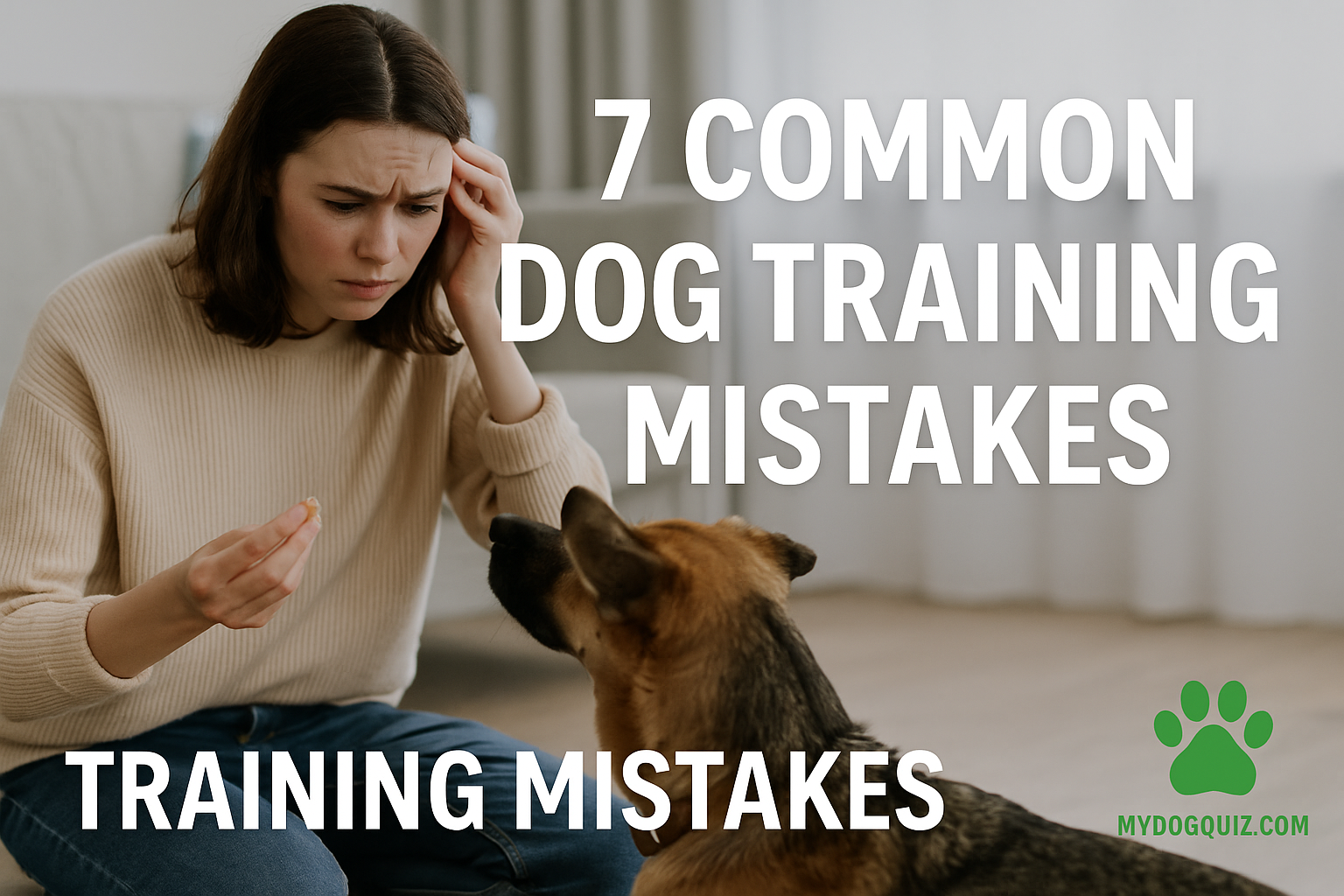You’ve put in the time. You’ve watched videos, read blogs, bought treats, maybe even paid for classes — but somehow, your dog’s behavior seems to be getting worse, not better.
They jump, bark, ignore commands, or act like you’re invisible. It’s frustrating and confusing, especially when you’re genuinely trying to do the right thing.
Here’s the surprising truth:
Most “bad” behavior isn’t caused by your dog — it’s caused by small, fixable training mistakes that confuse their brain.
Once you understand how your dog’s mind really learns, everything changes.
👉 Take the 30-Second Dog Brain Quiz to find out your dog’s learning type and how to train smarter, not harder.
1. Repeating Commands Too Often
We’ve all done it.
You say “sit”… your dog doesn’t respond… so you say it again — louder. Then again.
But every repetition teaches your dog that they don’t need to listen the first time.
To them, “sit” might mean “ignore the first two, act on the third.”
Fix it:
Say the command once in a calm, firm tone.
If your dog doesn’t respond, gently guide them into position, then reward them immediately.
This builds an instant association between your first command and the reward.
2. Training When You’re Frustrated
Dogs are emotional mirrors. They pick up on your tone, posture, and energy more than your words.
When you train while tired, angry, or impatient, your dog senses that tension — and training turns into stress.
That stress activates your dog’s reactive brain, not their learning brain, which blocks progress entirely.
Fix it:
Train in short, upbeat sessions (no more than 10 minutes).
End on a win, even if it’s something small like a sit or a handshake.
Your good mood is the best reward your dog can get.
3. Inconsistent Rules Between Family Members
This is one of the biggest hidden causes of bad behavior.
If one person lets the dog on the couch and another scolds them for it, the dog doesn’t know what’s right or wrong — only that the rules keep changing.
To a dog, inconsistency feels like chaos.
They’ll test boundaries endlessly just trying to figure out what’s “safe.”
Fix it:
Get everyone on the same page.
Create a short “House Rules for the Dog” list and post it where everyone sees it.
When consistency returns, behavior stabilizes almost overnight.
4. Overusing Treats as Bribes
Treats are powerful motivators — but when used incorrectly, they can backfire fast.
If your dog learns that they only obey when you have a treat in your hand, they’re not being obedient — they’re negotiating.
Fix it:
Phase out visible treats. Hide them or use them randomly instead of every time.
Replace some treats with praise, play, or petting — rewards your dog values just as much.
You want your dog to listen because they trust you, not because you’re holding a biscuit.
5. Punishing Confusion Instead of Teaching Understanding
When a dog fails to follow a command, most owners assume they’re being stubborn.
But more often, the dog is simply confused.
Yelling or using harsh corrections might stop the behavior momentarily — but it teaches fear, not understanding. Fear shuts down the learning process completely.
Fix it:
Switch from punishment to communication.
When your dog gets it wrong, calmly redirect them, show what you do want, and praise the moment they get it right.
Your goal is to make success crystal clear, not to make failure scary.
6. Forgetting Mental Stimulation
Physical exercise is great, but dogs need mental exercise just as much.
Without it, their brain gets bored — and boredom turns into barking, chewing, and misbehavior.
A dog that’s mentally challenged each day is calmer, happier, and far more focused.
Fix it:
Incorporate daily brain games like:
- Hiding treats under cups
- “Find the toy” challenges
- Teaching new tricks or names of objects
These engage your dog’s prefrontal cortex — the part responsible for focus and problem-solving — and make obedience training far easier.
👉 Want to know which brain games fit your dog’s learning style? Take the 30-Second Dog Brain Quiz.
7. Expecting Results Too Fast
Dogs learn through patterns, not pressure.
When you rush training, you accidentally build anxiety — and anxious dogs can’t focus.
Just like people, dogs need repetition and patience.
The key is micro-progress — small wins stacked over time.
Fix it:
Celebrate little breakthroughs.
If your dog stays focused for five extra seconds, that’s a success.
Progress might be slow at first, but once the brain “clicks,” results snowball fast.
The Domino Effect of These Mistakes
Here’s why these small missteps add up fast:
Each mistake chips away at your dog’s trust and focus.
Without trust, your dog’s brain goes into “fight, flight, or ignore” mode.
And when that happens, obedience collapses no matter how many treats or commands you use.
But the good news?
Once you retrain your approach, your dog’s brain resets — often in just a few days.
Brain-Based Training: The Smarter Way to Teach
Certified trainer Adrienne Farricelli discovered that the fastest way to fix problem behavior isn’t through force or dominance — it’s through mental stimulation.
Her Brain Training for Dogs program focuses on simple, science-backed games that unlock your dog’s focus, confidence, and obedience.
Instead of punishing bad behavior, her system rewires how your dog thinks — making them want to listen.
It’s fun, gentle, and surprisingly fast.
Real Story: Max and the “New Brain”
Lisa’s border collie, Max, was driving her crazy — barking at everything, chasing cars, and refusing to sit still.
She’d tried obedience classes and expensive gadgets with no luck.
Then she discovered brain games.
Within two weeks, Max was calmer, slept better, and followed commands on the first try.
Lisa didn’t “fix” Max — she just spoke to his brain in a way he finally understood.
That’s what makes brain-based training so powerful. It taps into your dog’s natural desire to learn, instead of forcing obedience.
Your Next Step: Discover Your Dog’s Learning Type
Every dog has a unique learning personality.
Some respond to visual cues, others to tone, others to problem-solving challenges.
When you train without knowing that type, progress feels random.
When you align with it, obedience becomes natural.
You can find out in seconds — and it’s fun.
👉 Take the 30-Second Dog Brain Quiz to learn how your dog’s mind works and get a free personalized training tip based on their results.
Final Thoughts
Dog training doesn’t have to be stressful, expensive, or confusing.
You don’t need to yell, repeat yourself, or rely on treats forever.
All it takes is understanding how your dog learns — and working with their brain instead of against it.
Because once you unlock your dog’s true learning style…
Listening isn’t forced. It’s automatic.
Take the quiz today and see how quickly things change.
👉 Start the Dog Brain Quiz Now »


Leave a Reply